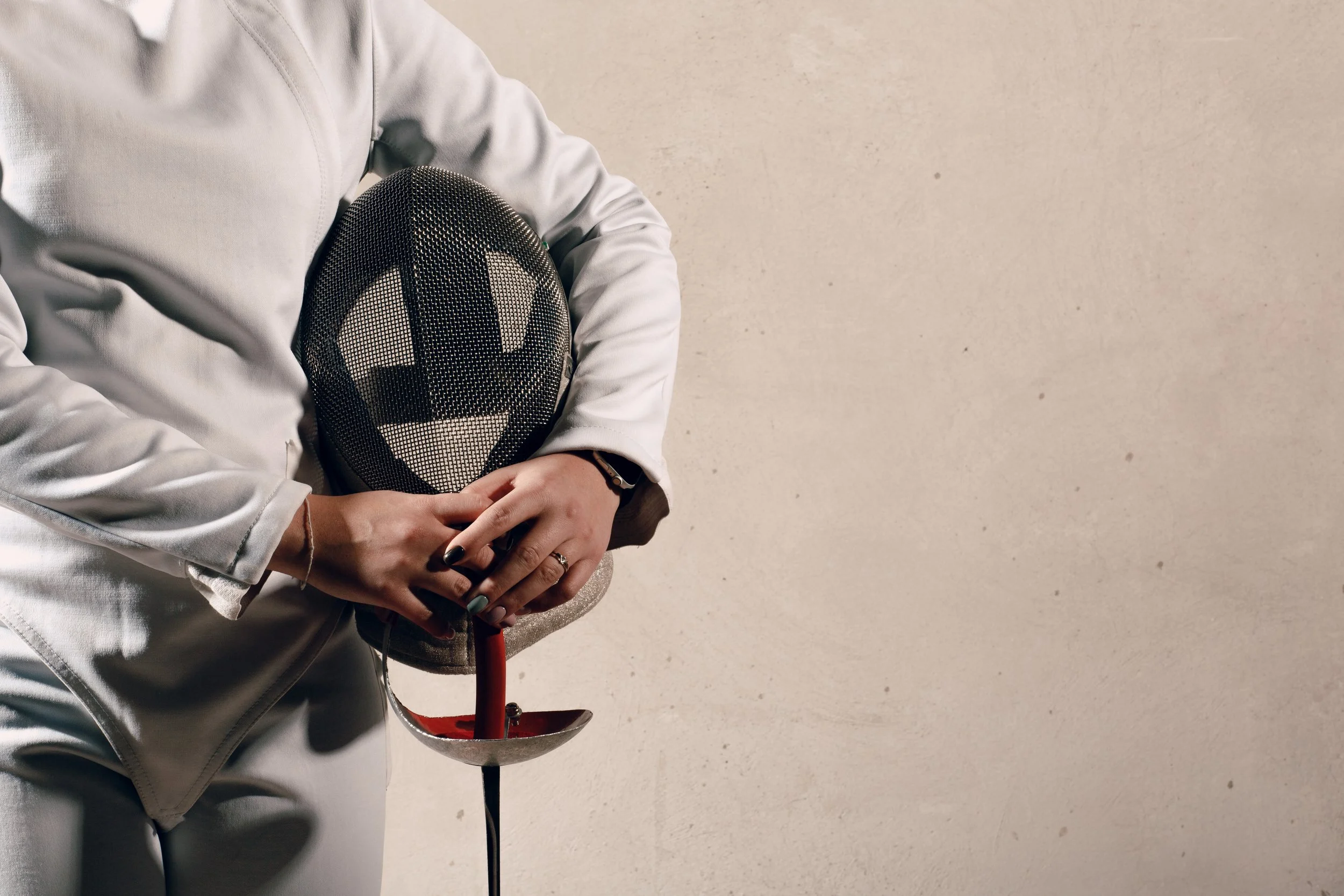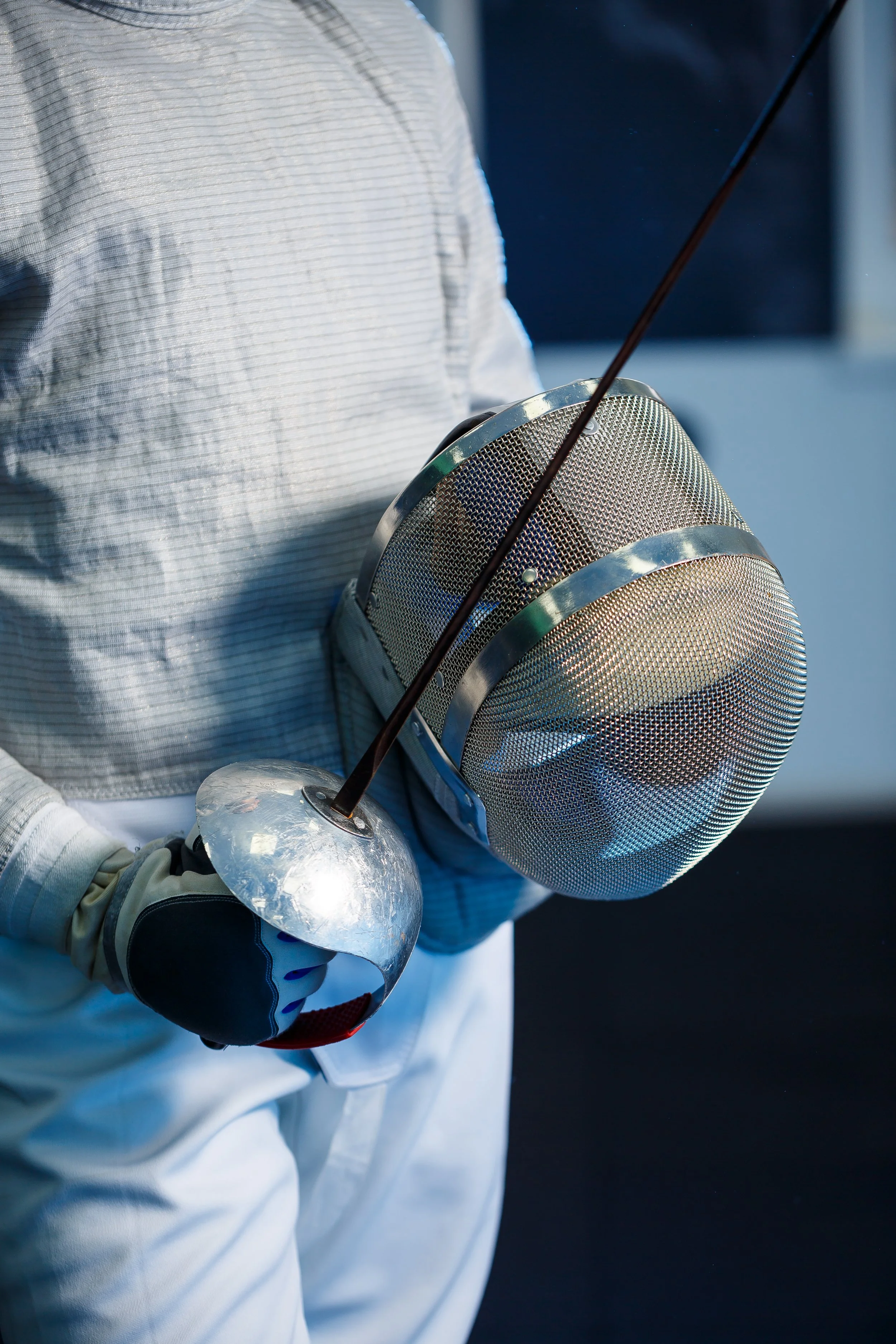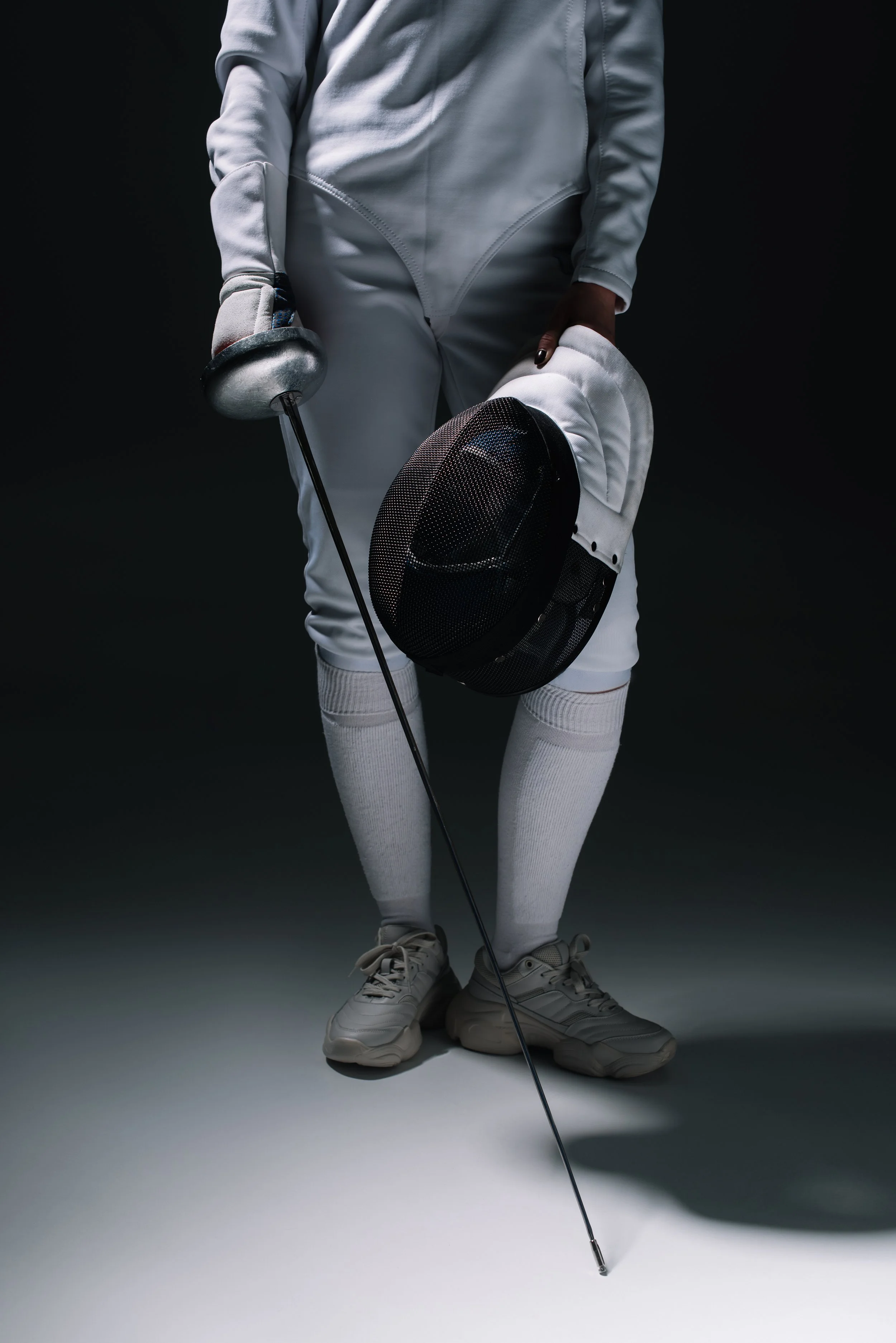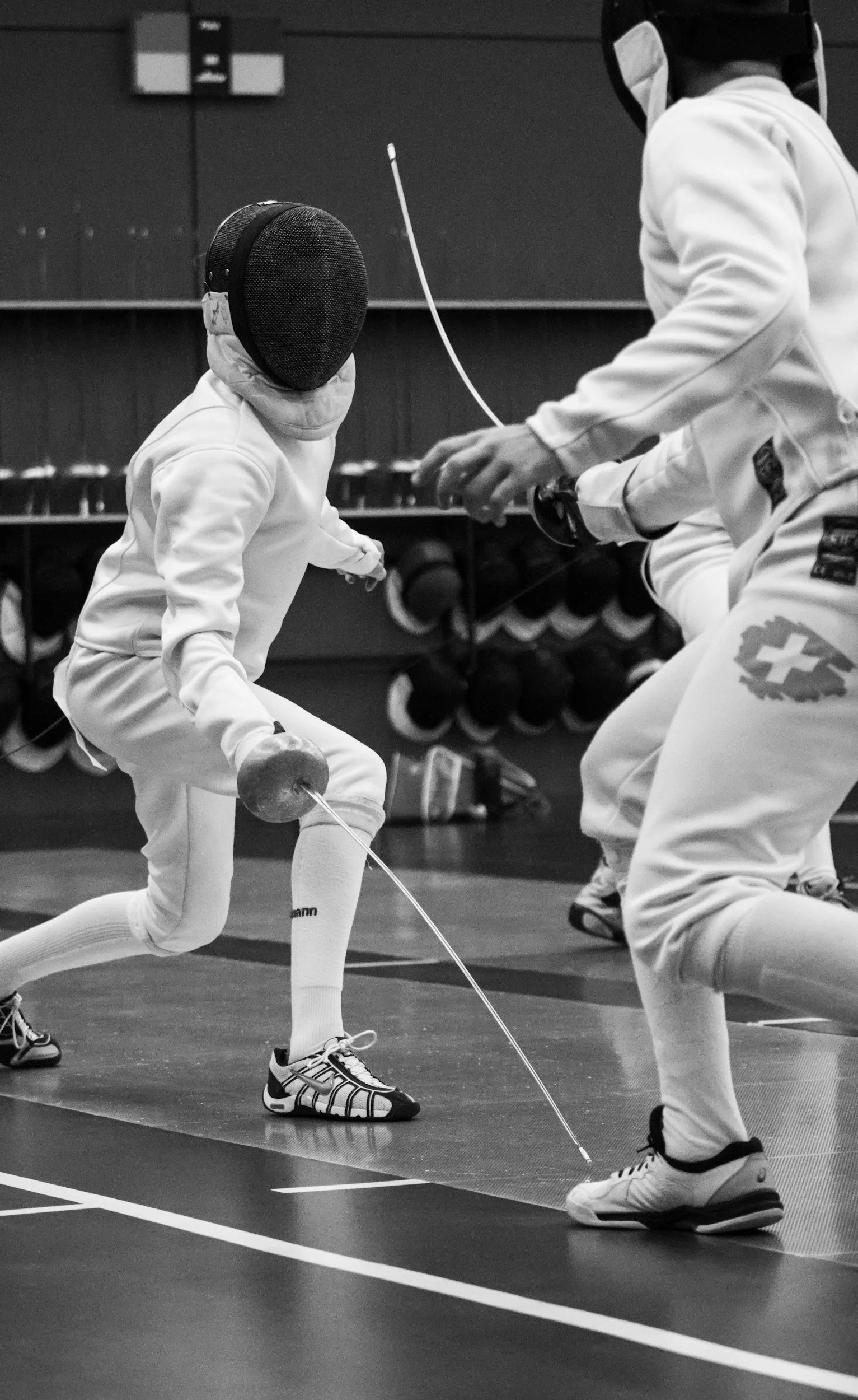
TOURNAMENT PREPARATION: The Gear
Preparing + Optimizing Your Fencing Equipment for the Tournament
Inspection & Maintenance
Why it matters:
Tournaments are often decided not just by skill, but by reliability. A loose screw, a dead body cord, or a failing mask strap can cost points—or even get you disqualified. Gear is your foundation. If it isn’t functioning, your preparation and tactics won’t matter. A disciplined inspection the day before ensures you step on strip with full confidence in your equipment.
-
Tip screws: Check both with a small screwdriver; replace if stripped or loose.
Blade alignment: Roll the blade across a flat surface to spot bends; minor curves are okay, deep ones need replacement.
Spring tension: Test with a weight (500g for foil/epee) to ensure tips are passing.
-
Continuity check: Plug into a test box or weapon; wiggle gently to reveal hidden shorts.
End fittings: Tighten prongs/sockets with pliers or screwdriver.
Mask cord: Inspect insulation for cracks—replace if wires are showing.
-
Strap security: Ensure elastic is firm, not stretched or fraying.
Mesh integrity: Press gently across surface; if wires shift or gaps form, replace immediately.
Padding/liner: Make sure foam is intact and comfortable—no slipping.
-
Glove seams: Check for tears, especially between thumb and fingers.
Conductivity: Test lames with a box; patch weak spots or replace if dead zones are large.
Zipper & velcro: Confirm secure closure.
-
Grip: Test soles for wear—smooth patches can cause slips.
Socks: Ensure entire legs are concealed.
Why it works:
By systematically inspecting and maintaining each piece of gear, you eliminate preventable failures. Instead of worrying about whether your tip will register or your cord will fail mid-bout, you free up mental energy for fencing.
Prepared gear = prepared athlete
Why it matters:
Nothing derails tournament focus faster than realizing you forgot a glove, ran out of tape, or only packed one working weapon. Disorganized gear not only adds stress, it also wastes mental energy you should be saving for the strip. Packing with structure—and building redundancy into your kit—ensures you arrive calm, confident, and fully prepared.
-
Pack at least two weapons and two cords (minimum competition requirement).
Bring backup socks, glove, and underarm protector—small items that fail often.
For serious competitors: a third weapon AND body cord is peace of mind.
-
Screwdriver (flat + Phillips), pliers, spare screws, and tip springs.
Athletic tape and electrical tape for emergency fixes.
Small towel or cloth to wipe sweat or clean blades.
-
Separate compartments for weapons, cords, clothing, and tools to prevent tangles.
Keep spares in labeled pouches (e.g., “cords,” “screws”) for quick access.
Place essentials (mask, glove, first weapon) at the top for easy reach during checks.
-
Pack fully the evening prior—never morning of.
Lay items out in a visible checklist, then transfer to bag.
Re-check once in the morning with fresh eyes.
Why it works:
Packing systematically means fewer surprises, faster gear access, and peace of mind. Instead of scrambling for a spare cord between bouts, you know exactly where it is. A well-organized bag creates a sense of control before you even step onto the strip.
Packing & Organization
Compliance & Readiness
Why it matters:
Tournaments have equipment and uniform standards (which vary by event level). Missing a detail—mask strap, lame conductivity, jacket rating, or membership paperwork—can mean failed control, rushed fixes, or even disqualification. Getting compliant before you leave home turns check-in and weapon control into non-events.
-
Read the event page/email for requirements (e.g., 350N vs 800N gear, FIE stamps where required, conductive foil bib rules, glove length, coach badges).
Note on-site weapon control procedures: what gets checked, opening times, and where to queue.
Bring federation membership/ID and any forms (age proof, medical/waiver) if the organizer specifies them.
-
Mask: Strap elastic firm, secondary security present if required; mesh undamaged; padding secure.
Jacket/Plastron/Breeches: Correct rating per event rules; zippers, closures, and seams intact; no holes/tears.
Glove/Sock coverage: Glove covers wrist/forearm as required; socks reach below knee; no exposed skin at cuff.
Foil/Sabre specifics: Lame (and foil conductive bib where required) free of dead zones; all clips/velcro secure; name/nation markings only if specified by the event.
-
Continuity: Test weapons, body cords, and mask cords with a box; gently wiggle to expose intermittent faults.
Dimensions/weights: Tips, springs, and overall lengths within spec for your weapon; screws tight and legal.
Labeling: Put your name/initials on cords, tools, spares, and each weapon to speed up control and recovery.
Packing for control: Keep to-be-checked items together (two weapons, two cords, mask/lame if required) in an easily accessed sleeve.
-
Screenshot check-in time, venue map, and weapon-control open times.
Plan to arrive early enough to clear control before warm-up—no last-minute queues.
Carry a micro-repair kit (screwdriver, spare screws/springs, tape) to fix minor issues on the spot.
Why it works:
Clarity on standards + a documented pre-check removes surprises, shortens lines, and prevents avoidable failures. You start the day calm, pass control on the first try, and keep your mental bandwidth for tactics—not paperwork or emergency repairs.
Notes on Compliance (varies by event level)
Some events require FIE-rated (800N) jacket, breeches, and plastron; domestic/local may allow 350N.
Foil conductive bib and Sabre conductive bib rules differ by federation/event—check the event page.
Name/Nation printing on lame/mask may be required at higher levels.
Always review the organizer’s weapon control checklist and opening times ahead of travel.
Full Gear & Uniform Checklist
Common (All Weapons)
-
☐ 2–3 working weapons (minimum 2)
☐ 2–3 body cords
☐ 1–2 mask cords (if required by your weapon)
☐ Test box (if you own one) or plan to test on strip
☐ Spare tips, screws, springs (for your weapon)
☐ Small repair kit: mini screwdriver(s), pliers, electrical tape, athletic tape
☐ Name labels/initials on cords, tools, and weapons
-
☐ Mask with secure elastic/secondary retention; mesh undamaged
☐ Underarm protector (plastron), correct rating per event rules
☐ Jacket, correct rating (e.g., 350N or 800N as required)
☐ Breeches (knickers), correct rating; no holes/tears
☐ Long socks (knee-height) — bring 2 pairs
☐ Glove (no holes or frayed seams) — bring a spare if possible
☐ Chest protector (mandatory for women; recommended for men where allowed)
☐ T-shirt or base layer (non-conductive under the lame)
☐ Shoes with good grip (broken-in), plus spare laces/second pair if you have them
-
☐ Federation membership/ID (and proof of age if needed)
☐ Event confirmation/registration proof (screenshot/email)
☐ Waivers/medical forms (if applicable)
☐ Permanent marker for labeling
☐ Towel, hand sanitizer, wet wipes
☐ Water bottle, electrolytes, snacks
☐ Spare socks, spare glove, spare underarm protector
☐ Gear bag with compartments (weapons sleeve + tool pouch)
Foil-Specific
-
☐ Foil lame (jacket) in good condition (no dead zones, secure zip/Velcro)
☐ Conductive mask bib (if required by your event rules) — passes continuity
☐ Mask cord for bib connection (if using conductive bib)
-
☐ 2–3 foil weapons (tips, wires, insulation checked)
☐ Check barrel/tip screws; carry spares that fit your barrels
-
☐ Non-conductive glove; no holes at palm or fingers
☐ Name/nation print on lame if the event level requires it
-
☐ Weapons pass continuity & tip tests (springs/weights per spec)
☐ All cords pass when gently flexed/wiggled
☐ Mask strap elasticity strong; secondary security present (where required)
☐ Lame/bib/Manchette continuity good; no obvious dead patches
☐ Jacket/plastron/breeches rating matches event standard (350N vs 800N where specified)
☐ Glove intact; no holes; cuff overlaps jacket sleeve
☐ Socks reach below knee; no exposed skin between breeches and socks
☐ Items for weapon control grouped together (2 weapons + 2 cords + mask/lame as needed)
Épée-Specific
-
☐ 2–3 épée weapons (tips/springs pass weight & gauge; no bent barrels)
☐ Correct point screws and spare springs
-
☐ Body cords (3-pin) tested; no intermittent faults
-
☐ Standard mask (no conductive bib needed)
☐ Non-conductive glove; full forearm coverage
-
☐ Tip screws & springs (weapon-specific)
☐ Extra body/mask cords
☐ Extra glove, socks, and tape
☐ Extra mask strap
☐ Heat-shrink/electrical tape for emergency insulation
Sabre-Specific
-
☐ Sabre lame (jacket) — good conductivity, no holes
☐ Sabre mask with conductive bib (required)
☐ Mask cord (to connect bib)
☐ Conductive manchette (cuff) if your glove requires it (some gloves integrate this)
-
☐ 2–3 sabres (guard insulated, blades straight, tips/blade ends legal)
-
☐ Sabre glove compliant with cuff/overlay rules (no exposed skin at wrist)
☐ Name/nation on lame if required by the event
Day of the Tournament
Success on competition day hinges not just on physical skill and pre-event prep, but on what you do between the first salute and the final touch. Your ability to find focus—to quiet noise, center your attention, and step on strip with a clear first action—keeps your fencing clean when the venue is loud and the schedule chaotic.
Once focused, you have to stay tactical. Treat the first exchanges as reconnaissance: read distance, tempo, and parry habits, then adjust every few points. Run simple A-B-C plans that fit the opponent in front of you, not the one you imagined. Tactical flexibility turns close bouts into controlled ones.
And when the day throws you a bad call or a sloppy action, reset fast. One breath, one cue word, one trusted action—back in. The fencers who recover in seconds, not minutes, protect momentum and make composed decisions under pressure.
At Mind & Blade Academy, we teach that poise, adaptability, and rapid recovery are the true separators on tournament day. Master these in-bout habits and your preparation pays off where it matters most—on the strip, touch by touch.




